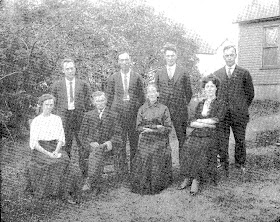Samuel J. Owen and Vera Edna Sedgwick were married October 29, 1905 at the bride's home one-half mile west of Jerome, Appanoose County, Iowa. They were first generation descendants of the early settlers who came to this county in the 1850s -- his from Putnam County, Indiana -- hers from Pennsylvania and Virginia (now W. Va.).

Sam & Vera Owen
Sam Owen was born September 30, 1874, in Lincoln Township, the youngest son of Thomas and Mary (Morlan) Owen. His grandparents were Henry and Belinda (Jones) Morlan (or Moreland). His great-grandparents were William and Abigail (Davis) Jones. (Grandmother Belinda Carolyn Jones was born in Casey County, Kentucky in 1818.) His grandparents on the Owen side were John A. and Nancy Owen. John died in Putnam County, Indiana, in 1853. Nancy came to this county with her four sons and one daughter: Owen, James, Greenbury, Thomas, and Nancy, around 1859.
Vera Sedgwick was born April 10, 1887, the youngest daughter of Benjamin Franklin Sedgwick and Katharine (Thomas) Sedgwick. Her maternal grandparents were Asbury and Mary Ann (Bowers) Thomas of Concord vicinity. Katharine Thomas was the only grandparent born in this county (1854). On the Sedgwick side Vera's grand-parents were Joseph Sedgwick and Priscilla (Rice) Sedgwick of Rice's Landing, Pennsylvania.

Benjamin Franklin & Katharine Thomas Sedgwick Family
Vera, Tom, Ben Sr., Owen, Katherine, Bill, Anna & Ben
"Sam and Vera" as they were known, made their home on an 80-acre farm three-fourths of a mile west of Jerome, bought from John Moore, which brought their land holdings to 280 acres. Around 1910 they professed belief in Christ "for time and eternity." They met regularly for church services with a small group of Christians sometimes called the "Believers," and lived a life of faith for all their years. Their story is the story of the family farm in the first half of the 20th Century, and it's a good one. Sam saw the farming operation go from the ox-yoke to the tractor; but most of the hard work, in his day, was done by horses and man power. There were usually four to eight horses in the barn or pasture, well-trained and well-cared for. He was an inventive engineer with a great respect for machinery. One of his first possessions was a fine, tall windmill over a fine, deep well. It must be nearly 90 years old now, and still runs, filling a cistern, which gravity feeds water to a stock tank, as needed. In the "summer kitchen" at their home, a stationary gasoline engine, with a crankshaft and series of pulleys, ran the washing machine, cream separator, and churn, and pumped water, which was piped to several places as directed. He was usually among the first to adopt new practices: diversified farming, rotation of crops, terracing and plowing on the contours, planting hybrid seed corn, raising alfalfa and soy beans. And he was always interested in community affairs, such as the school (he was usually on the School Board) and politics (he was a Democrat).
Vera was beautifully supportive in every conceivable way. The garden orchard and farm yard provided a wealth of fruit and vegetables, including grapes, apples, peaches, pears, cherries, plums, strawberries in abundance. Collecting and preparing these for food in season, and canning and preserving them for later use was a major activity; and there was always a fine flock of chickens in the henyard, contributing their part of the family table. Vera had many gifts, she was a great seamstress and a good portion of the family clothing was made by her. She was also a fine singer and pianist. Often the old farmhouse hummed with music, both vocal and instrumental, in which everyone had a part.
They lived a happy, if strenuous life; raised six children, without catastrophe; and survived the great depression -- being loved and respected by many. They were true positive thinkers before that phrase was coined. They would probably consider their children their greatest accomplishment. They hoped to endow them with an inheritance of good health, good character, and an education of their choosing. One son continues on the "home place" to carry on family traditions.
Sam died in 1940, age 65. Vera followed him in 1952, age 65.



Gravestone in the Jerome Cemetery for
Samuel Owen and Vera Sedgwick
Samuel Owen and Vera Sedgwick
-------------------------------
Text transcribed with permission from the Appanoose County Historical Society from Appanoose County Iowa, written by the people of Appanoose County, compiled in 1984-1985 by the Appanoose County Historical Society, and printed by Taylor Publishing Co., Dallas, Texas (1986). First two pictures scanned from Memories of Jerome, Iowa 1989.
No comments:
Post a Comment